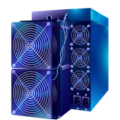Asic Miner Profitability
Our mining profitability calculator helps users quickly pinpoint the most lucrative mining options by delivering real-time data in multiple fiat and cryptocurrency currencies, including USD, EUR, GBP, AED, CAD, AUD, THB, ETH, and BTC. It allows precise electricity cost inputs up to three decimal places for highly accurate profit estimations. Users can access a clear overview of top-performing miners, algorithm-specific performance tables, and visually organized listings of mineable coins with recognizable cryptocurrency icons, simplifying decisions for maximum returns.
| Model | Hashrate |
Profitability
Profit
|
|---|---|---|
|
Bitmain Antminer S23 Hyd 3U
1160TH/s
|
1160 TH/s |
$30.34/day
|
|
Bitmain Antminer S21e XP Hydro
860TH/s
|
860 TH/s |
$16.71/day
|
|
Bitmain Antminer S23 Hydro
580TH/s
|
580 TH/s |
$15.17/day
|
|
Bitdeer SealMiner A3 Pro Hydro
660TH/s
|
660 TH/s |
$13.46/day
|
|
Proto Rig
819TH/s
|
819 TH/s |
$13.32/day
|
|
Bitmain Antminer S21 XP+ Hyd
500TH/s
|
500 TH/s |
$11.64/day
|
|
Bitmain Antminer S21 XP HYDRO
473TH/s
|
473 TH/s |
$10.10/day
|
|
Auradine Teraflux AH3880
600TH/s
|
600 TH/s |
$9.93/day
|
|
Bitmain Antminer S23 Immersion
442TH/s
|
442 TH/s |
$9.44/day
|
|
Bitdeer SealMiner A3 Hydro
500TH/s
|
500 TH/s |
$9.24/day
|
|
Bitmain Antminer S21e XP Hyd
430TH/s
|
430 TH/s |
$8.36/day
|
|
Bitdeer SealMiner A2 Pro Hydro
500TH/s
|
500 TH/s |
$7.89/day
|
|
Bitmain Antminer S23
318TH/s
|
318 TH/s |
$7.40/day
|
|
Bitmain Antminer S21+ Hydro
395TH/s
|
395 TH/s |
$6.16/day
|
|
Canaan Avalon A16XP
300TH/s
|
300 TH/s |
$5.93/day
|
Our cutting-edge mining calculator offers comprehensive insights across all major cryptocurrency algorithms, helping users easily identify the most profitable options for their specific hardware. The algorithm data is continuously refreshed to keep pace with the dynamic crypto mining industry, providing accurate evaluations based on real-time profitability statistics and overall market activity. This empowers users to make well-informed choices that reflect the latest mining conditions and algorithm performance.
Bitcoin Mining Difficulty
Monitor the latest Bitcoin network difficulty metrics in real time, including block times & estimated time until the next difficulty adjustment.
Progress
Current progress:
61.51 %
Remaining Block
Blocks Left:
776
Remaining Time
Time Left:
~ 5 days 1 hours
Next Change
Upcoming change:
6.9 %
Block Time
Current Block Time:
9.4 minutes
What is SHA-256 algorithm?
Why Should You Rely on Our Profit Calculator for Accurate Mining Insights?
SHA-256 is a 256-bit cryptographic hash that maps any input to a fixed-length digest and resists preimage, second-preimage, and collision attacks under current knowledge. In Bitcoin it anchors Proof of Work as miners hash the 80-byte block header twice with SHA-256 until the result falls below a target encoded in nBits. They sweep the search space by changing the nonce, the timestamp, and the coinbase so the Merkle root shifts, while the header fields sit under a cold, exacting focus. A valid block appears when the double-hash is numerically less than the target, which defines difficulty and the expected effort. Bitcoin adjusts difficulty every 2016 blocks to keep the average block time near ten minutes as network hash rate moves. The double application of SHA-256 also dampens length extension issues that affect Merkle–Damgård designs when a digest is reused as an identifier. SHA-256 is compute-bound and light on memory, so ASICs can unroll and pipeline the 64 rounds for extreme throughput, while GPUs and CPUs lag on efficiency. This optimization lifts security through higher aggregate work yet pushes energy demand and can concentrate mining in large operations. Pools reduce payout variance but introduce coordination and fee overhead. Miner profitability hinges on device hash rate, energy efficiency in joules per terahash, electricity mix, uptime, pool fees, orphan risk, transaction-fee share, and halving events that cut the block subsidy about every 210,000 blocks. Beyond mining, SHA-256 supports digital signatures by hashing messages, secures certificate chains, verifies firmware and software integrity, and guards data at rest or in transit. No practical collisions are known, and reversing a digest remains infeasible on classical hardware. Quantum search could yield a square-root speedup for preimages, which lowers effective security, yet the 256-bit space leaves a broad safety margin today. Under this steady cadence of work and retargeting, blocks arrive with clockwork restraint while the ledger records transactions with a traceable cost.
Latest ASIC Miners
Check out the latest ASIC miners added to our site. These are the newest listings, featuring the most recent models.
V3
Nerdminer
AE3
IceRiver
Antminer L11 Hyd 2U
Bitmain
Why ASIC Mining?
The Advantages of ASIC Mining Compared to Other Mining Types
ASIC (Application-Specific Integrated Circuit) mining involves specialized hardware designed exclusively for mining cryptocurrencies like Bitcoin, offering unmatched efficiency and performance. Unlike general-purpose GPUs, ASICs are optimized for specific algorithms, delivering significantly higher hashrates while consuming less power per hash. This makes them far superior for mining tasks, as they maximize profitability by reducing electricity costs and increasing mining output. ASIC miners are purpose-built, providing stability and reliability in high-demand mining environments, unlike GPUs which are prone to overheating and wear during prolonged use. Their compact design also allows for easier scalability in large mining operations. By focusing solely on mining, ASICs eliminate the overhead of multi-purpose computing, resulting in faster block-solving times. This efficiency translates to higher rewards, making ASICs the preferred choice for serious miners aiming to stay competitive in the cryptocurrency market. In contrast, GPU mining, while versatile, cannot match the raw power and cost-effectiveness of ASICs for dedicated mining tasks.
Optimized for Mining
Energy Efficient
Reliable & Stable
Scalable
More about the SHA-256 algorithm
See how our profit calculator delivers accurate, real-time mining insights, helping miners make informed decisions.
SHA-256, the 256-bit member of the SHA-2 family standardized by NIST in 2001, forges a fixed-length fingerprint from data of any size and stands as a one-way gate whose preimage resistance is on the order of 2^256 and collision resistance about 2^128, with an avalanche effect that scatters even a single-bit change across the whole digest; built on a Merkle–Damgård construction with a dedicated 64‑round compression function over 512‑bit blocks, it relies on simple, fast 32‑bit operations (rotates, shifts, choice, majority) and constants derived from fractional prime roots, and while reduced‑round cryptanalysis exists in the literature, there are no practical collisions known, which is why SHA‑256 anchors digital signatures, HMACs, software integrity checks, firmware updates, and modern certificate chains in everyday security systems; in Bitcoin it is applied twice to the 80‑byte block header as proof of work, with miners iterating the nonce and adjusting the coinbase‑driven Merkle root (the so‑called extraNonce technique) until the resulting hash falls below a target encoded in nBits, a target that retunes roughly every 2016 blocks to stabilize block intervals, and this mechanical ritual-part competition, part bulwark-enforces ordering of transactions and makes double‑spending or long‑range reorganizations prohibitively costly; compared with memory‑hard designs like Scrypt or Ethash, SHA‑256 is light on memory and thus highly ASIC‑friendly, spawning specialized hardware whose efficiency is tracked in joules per terahash and whose rise has concentrated hash power into industrial fleets and pools coordinated by protocols such as Stratum, yet the open contest for blocks, the ease of verification for every node, and the sheer expense of amassing majority influence continue to hold the line for decentralization; beyond block headers, Bitcoin employs double SHA‑256 for transaction IDs and Merkle trees, and more broadly the function underpins commitment schemes, randomness beacons, and key derivation when wrapped in HMAC (as in widely used constructions like HKDF), so that many voices can argue-some warning that centralization is a slow encirclement, others insisting that thermodynamics and market churn keep any single commander from the field-but the hash remains indifferent, a mute sentinel reducing chaos to 256 bits, and in that indifference lies integrity: transparent verification at massive scale, practical resistance to tampering, and a predictable race that miners analyze with profitability models balancing hardware efficiency, energy use, and difficulty trends, even as the network gathers their work into a ledger whose security rests, quietly and stubbornly, on the unyielding math of SHA‑256.
 English
English
 German
German
 Hungarian
Hungarian
 Dutch
Dutch
 Spanish
Spanish
 French
French
 Italian
Italian
 Czech
Czech
 Polish
Polish
 Greek
Greek



















